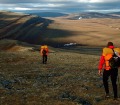Running barefoot can be an exciting and refreshing way to run, characterized by its naturalness and simplicity. The idea of running through nature without shoes conveys a sense of freedom that is unmatched.
But how do you manage to run barefoot without getting injured or feeling pain? In this comprehensive article, we delve into all aspects of barefoot jogging and show you how to make this wonderful activity safe and effective.
What is Barefoot Running?
Barefoot running means running without the support of traditional running shoes. This form of running is often considered more natural and efficient as it allows the body to move as nature intended. While many people consider wearing shoes as protection against injuries and rough terrain, barefoot runners argue that ditching shoes leads to better running styles and a stronger connection to the environment.
Why is Barefoot Running Important?
In our modern society, many people have moved away from the natural way of moving. Running barefoot offers us the opportunity to experience the world around us in a direct and unadulterated way. It promotes awareness of our movements and can help correct imbalances and postural issues that arise from the constant wearing of shoes.
The Philosophy Behind Barefoot Running
The philosophy of barefoot running is based on the idea that the human body is perfectly suited to run without shoes. Many advocates of barefoot running argue that modern running shoes limit the body’s natural movement and can lead to injuries. By running barefoot, the body is encouraged to move in a way that is more natural and efficient, ultimately leading to better well-being.
Origins and Traditions
Barefoot running is as old as humanity itself. Our ancestors roamed the world barefoot or with minimal foot protection. In many cultures, barefoot running was and still is a daily practice. Historical records show that runners in ancient civilizations, such as Greece, often competed barefoot. Even in the modern world, there are indigenous peoples who traditionally run barefoot and achieve impressive running feats.
Barefoot Running in the Modern World
With the invention of modern running shoes, barefoot running has lost popularity. But in recent years, it has made a comeback, especially through interest in natural movement and minimalist running techniques. Books like „Born to Run“ by Christopher McDougall have reignited interest in this practice, and many runners worldwide are rediscovering the benefits of barefoot jogging.
The Science of Barefoot Jogging
Physiology of Barefoot Running
Running barefoot significantly alters the biomechanics of running. Without the cushioning and support of shoes, the foot must work harder to ensure stability. This leads to increased activation of the foot muscles and improved proprioceptive perception. Studies show that barefoot runners often have a shorter stride length and a higher cadence, which reduces the load on the joints.
Research and Studies
In recent years, numerous studies have examined the effects of barefoot running. Research shows that barefoot running can lead to better foot muscles, improved balance, and a lower injury rate. Some studies have also shown that barefoot running improves running style by promoting a more natural foot position and supporting a midfoot strike.
Benefits of Barefoot Jogging
Improved Foot Musculature
One of the most apparent benefits of barefoot jogging is strengthening the foot muscles. Without the support of shoes, the muscles in the foot have to work harder to ensure stability and balance. This leads to stronger and more resilient foot muscles that are better able to support the body while running.
More Natural Running Technique
Barefoot running promotes a more natural running technique that moves the body more efficiently. Many runners tend to land heel-first in shoes, which can lead to unnecessary joint stress. Barefoot runners often land on the midfoot or forefoot, reducing impact and enabling a more efficient running movement.
Benefits for the Joints
Barefoot running can help reduce stress on the joints. Through the body’s natural shock absorption and improved running technique, the joints are less stressed, reducing the risk of injuries such as knee problems or stress fractures.
Psychological Benefits
In addition to physical benefits, barefoot running offers psychological benefits. It can convey a sense of freedom and independence that is often lost in today’s fast-paced world. Many barefoot runners report increased body awareness and a deeper connection to nature, contributing to increased well-being.
Risks and Challenges
Common Injuries
As with any sport, there are risks associated with barefoot running. Common injuries include cuts, bruises, blisters, and overuse injuries. Without the protection of shoes, the foot is more susceptible to external influences, which can lead to injuries if not careful.
How to Minimize Risks
To minimize the risks of barefoot running, starting slowly and giving your feet time to adapt is essential. Running on soft surfaces, avoiding uneven terrain, and gradually increasing running distances can help prevent injuries. It’s also advisable to regularly check and care for the soles of your feet as needed.
Starting with Barefoot Jogging
How to Prepare Your Feet
Before you start barefoot jogging, it’s essential to prepare your feet for the new challenges. This includes strengthening the foot muscles through exercises such as toe raises, foot circles, and balance exercises. Walking on different surfaces can also help desensitize your feet and prepare them for barefoot running.
Learning the Right Techniques
The right technique is crucial to avoid injuries while barefoot running. Start with short distances and focus on landing on the midfoot or forefoot. Ensure your steps are short and light to minimize joint stress. Consulting an experienced barefoot runner or trainer can help refine your technique.
First Steps and Training Sessions
Getting into barefoot jogging should be gradual. Start with short training sessions on soft surfaces such as grass or sand. Slowly increase the distance and intensity to allow your feet time to adapt. Pay attention to your body and take breaks if you feel pain or discomfort.
Running Barefoot on Different Surfaces
Grass
Grass is one of the best surfaces for barefoot runners, especially beginners. It is soft and cushioning, minimizing the risk of injury. Running on grass also promotes natural running movement and helps strengthen foot muscles.
Sand
Running on sand provides an excellent workout for foot muscles. It is demanding but also rewarding as it increases the stability and strength of the feet. However, note that uneven sand surfaces can present additional challenges. It’s essential to be cautious to avoid overexertion.
Asphalt
Asphalt is a commonly used surface but requires special care. Since it is harder than grass or sand, the stress on the joints can be higher. However, for advanced barefoot runners, running on asphalt can be an opportunity to improve their technique and endurance.
Forest Trails
Forest trails offer a varied and often challenging surface for barefoot runners. The uneven terrain can help improve balance and coordination but requires increased attention to avoid tripping hazards and sharp objects.
Training Tips for Barefoot Runners
Warm-up and Cool Down
A thorough warm-up and cool-down are crucial to avoid injuries. Start with light stretching exercises and a short walk to prepare the muscles for the upcoming stress. After running, stretching exercises and a short cool-down phase should not be missed to support recovery.
Training Plans for Beginners
A good training plan for beginners should be slow and gradual. Start with short distances and slow speeds to get the body used to the new stress. Increase intensity and duration only when you feel comfortable and confident.
Advanced Training Techniques
For experienced barefoot runners, numerous techniques can intensify training. Interval training, hill runs, and strength training can help increase performance and further strengthen foot muscles. Experiment with different techniques to find what works best for you.













